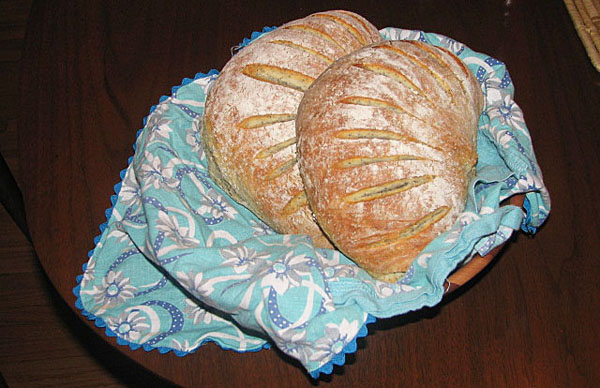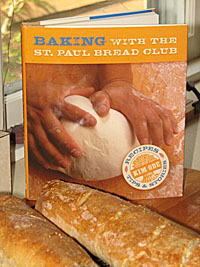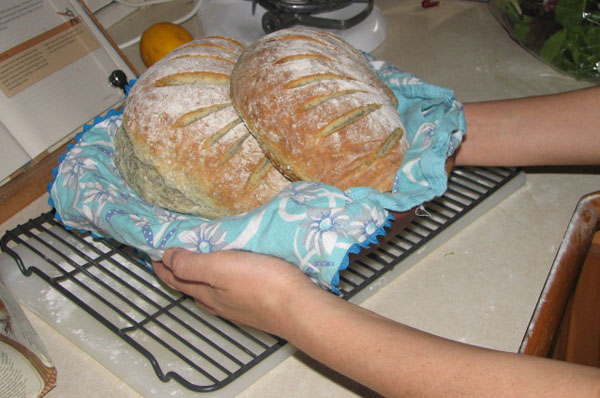
When it comes to baking, Karen Vogl has got a point: “I look at it as a hobby or craft,” she says, “like making a quilt or throwing pots. But you can only do so many of those. I mean, people don’t usually need one more quilt or one more pot. But everyone always needs bread.”
Yet it’s possible that she is simply justifying her all-consuming desire to create the quintessential baguette — an obsession that has led her to fill the bottom of her oven with rocks. Vogl is one of 13 quirky home bakers profiled in Baking with the St. Paul Bread Club, Kim Ode’s 2006 cookbook, which seeks, through its interviews, recipes and baking tips, not to explain the how-to of baking but rather to express the why.

If you are at all cynical, you may be adding up club, recipes, and home bakers and coming up with the spiral-bound notebook of recipes your grandmother once published with the Ladies Literary Club. Although those recipe annuals, like Jell-O, Ritz crackers, and mayonnaise, have a place, this is a very different sort of cookbook for several reasons.
First, there is Ode. Eight years ago, the veteran reporter built a wood-fired brick oven in the backyard of her Edina home, where she regularly spends whole days baking off loaves of sweet and savory bread. And so her writing is informed and genuine, turning dedication to artisan breads and a warm knowledge of the St. Paul Bread Club into a cookbook that is thoughtfully organized and full of great recipes and home-grown wisdom.
Then there are the people. Ode’s community of bakers have a common devotion, but each profile tells of an individual journey to bread. These stories make Baking a sweet, sometimes funny read, providing insight into both the origins of the recipes and the character of St. Paul Bread Club.
According to Ode, Dan “Klecko” McGleno formed the St. Paul Bread Club with the idea that Twin Cities home bakers should have a forum to “talk bread, trade tips, hear what a master baker advises, bake their own dough, and eat each other’s bread.” For many years, the group has met once a quarter at the St. Agnes Baking Co., which this magazine wrote about earlier this month and where Klecko oversees the bakery as CEO. In time, the club has taken on a life of its own, growing to more than 500 members, many of whom have formed ad hoc meet-ups in their own communities.
Klecko has his own “How to Start Your Own Bread Club” section in Baking. It offers a few strong pieces of advice in keeping with the spirit of the club, among them the sage warning to avoid conflict by leaving money out of it — membership should be free. And it talks about how the club evolved from his original intentions.
In the beginning, Klecko gave a lot of demonstrations introducing topics of baking science, math and theory, but at some point he realized that folks were more interested, as he says, in the romantic side of things: “ … the vast majority of my baking companions were on individual quests to re-create particular breads and that those breads would serve almost as passports to a cherished family member or a significant place.”
Add to that soulful longing a mix of generosity, healthy desire to control what one eats, artistic expression, familial predisposition, and a simple need to work out a bad day punching down dough. “Kneading is a full body experience,” writes Ode, “a leaning in and pushing through all the way from your firmly planted feet to your shifting shoulders. A really stiff dough should leave you a little winded. As it grows smoother and bouncier, the dough absorbs frustrations about a job, worries about a parent… Why bore your friends? Your dough will not only absorb these things but transform itself into comfort food.”
Nothing, but nothing, is more comforting than bread, hot out of the oven. And it is the recipes that, finally, make Baking a keeper. Getting back to an earlier point, other clubs may put together recipe books for a variety of reasons — raising money, perhaps — but food really has nothing to do with their overall purpose and the results are often a little dismal. Here, obsession has led the St. Paul Bread Club bakers to work at their recipes, sometimes for years, getting the crust, crumb, and flavor just where they want it, and that work pays off in recipes that deliver beautiful, delicious loaves.

One evening at home, we vented our spleens on Lauren “Lorenzo” Allen’s Buttermilk Poppy Seed Bread. With only two hour-long rises, it fit perfectly into the workaday schedule, turning out two beautiful crescent-shaped loaves in time for dinner. Although we might have waited for them to cool, we were only following directions when we placed them on the table, slicing and buttering with the meal.
Allen’s bread features a nice, firm crust and the kind of crumb that is equally good for toast and sandwiches; not too dense, not too dry. The recipe calls for up to a cup of poppy seeds, which admittedly gave us pause but — as the author says — fear not! It adds a certain nuttiness and a pleasant pop, yet it doesn’t drown out the buttermilk’s slight sour flavor.
We also loved the golden crust of the Char Johnson’s French Bread. Ironically and very much to Klecko’s point, the loaves filled our house with the intoxicating smell of white bread, which took all of us city people back to the Wonder Bread factories of our childhood. But the final product was something else: salty-sweet, deliciously soft white insides, and a crunchy crust. Heaven.
Johnson’s advice: Dough can behave differently from season to season, so it is better to adjust your ingredients, paying attention to how the dough feels, than to stick to the recipe.
On the softer side, Pat Roberts’ Finnish Cardamom Bread bakes into to pretty braided loaves that beg to be pulled apart and eaten directly out of the oven. It is lighter than brioche and softer than challah, pillowy soft, in fact, and not at all dry. With its fragrant sweetness, cardamom bread would be fabulous at brunch. The only drawback is that it took almost four hours to rise, a time commitment that made its fleeting goodness all the more sweet.
On the other hand, as Ode and her fellow bakers are quick to note, that’s not much of a time commitment. After all, one needn’t stand over the bread watching it rise.
In that way, Baking with the St. Paul Bread Club takes a different tone than Hertzberg and Francois’ Artisan Bread in Five Minutes a Day. Yet it is also strikingly similar, in that its infectious enthusiasm and straightforward recipes successfully encourage people to reclaim the craft of home bread baking, for the sake of art, sanity, and truly tasty bread, but also for the health of our communities. One wonders if it rings more true to today than it did even three years ago, with the economy down — surely we are cooking at home more, but might we also be looking for comfort in our communities, bread or otherwise?
As Ode writes of her wood-fired brick bread oven: “I wanted to re-create the culture of a French village where neighbors would bring their risen dough to the communal oven. As our breads emerged, our bonds would strengthen. Gathered at the hearth, friends and neighbors would build connections that would cross the boundaries of gender, age, politics, and class.”
Hear, hear!
Many thanks to Laura Arneson for contributing her strong baking skills and arms to recipe testing the Finnish Cardamom Bread — and for sharing the fruit of her labor.
Baking with the St. Paul Bread Club
By Kim Ode
156 pages, $24.95
The Minnesota Historical Society Press (2006)

Susan,
Thanks so much for this story! I sense kindred spirits. Laura really went to town on these recipes. And I’m so pleased that you totally grasped what I believe to be an inherent generosity among breadbakers. No secret recipes here, but an honest desire to share their knowledge and pleasure with others. I’m grateful to Klecko for giving us a platform for our skills, to all the bakers for telling their stories, and to you for noticing.
By the way, I’ve been so impressed with Heavy Table. You guys are working hard, and I’m enjoying the fruits of your labor.
For those who want to know more about the bread club, our web site is http://spbc.info.
Dearest Pagani,
Thanks so much for sending a breeze to keep the dream afloat.
Regards – Klecko